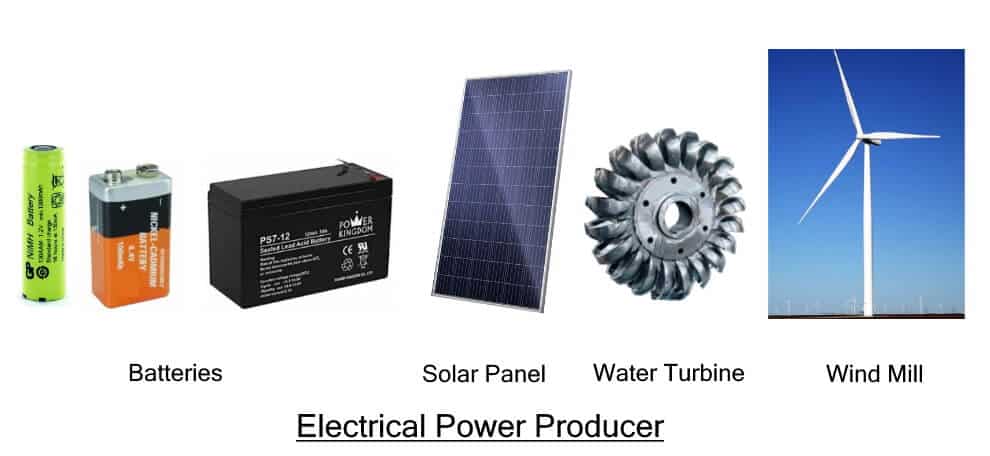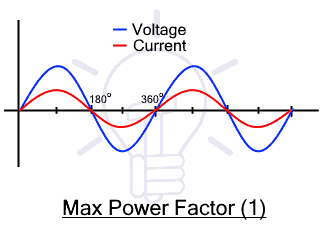What is Electric Power & How to Calculate its Different Types with Units
Electricity is one of the basic necessities in these modern times & we cannot imagine our life without it. In either form such as a stored DC in batteries or the AC mains from the utility poles, in both cases, we use it to power our daily life equipment & our industries utilizes it to run machines to manufacture goods & offer services. The amount of electricity we use is measured on the basis of electrical power.
What is Electrical Power?
Every electrical equipment or device that we use has specific power ratings mentioned on it. It means it consume that specific rated power & converts that electrical power to good use. Such as a cellphone, utilizes the power from the battery, to power its display unit (converting it into light), speakers (for audio generation) & its processors (for logical operations) etc. Same as machines that consumes electrical power & generates mechanical power & heater generates heat energy.
Generally, the definition of power is the rate of energy transferred or the energy transferred in a unit time.
So according to the definition, the electrical power is the rate of flow of electrical energy or the work done on electrical charges in an electrical circuit.
The electrical energy is the energy stored in charge Q under the influence of voltage V (potential difference). Hence the electrical power is;
P = Electrical Energy / Time = (V x Q) / t
Where Q / t = I, because the flow of charge per unit time is called electrical current denoted by I.
P = VI
In an electrical circuit, we can say that the power consumed or generated by a component is equal to the product of the voltage drop across it & the current flowing through it.
Unit of Power
Since the electrical power is flow of energy per unit time & the unit of energy is joule.
Electrical power = Joules / Second = J/s
The SI unit of electrical power is watt represented by W.
Watt, W = Joules / Second
One Watt is defined as, the electrical power consumed, when one volt of potential difference is applied to a circuit & it forces one ampere of current to flow through it.
The power can range from small figures to very large figure that is simplified using prefixes such as mill watt mW, Kilowatt kW, megawatt MW etc.
Calculation of Electrical Power
The electrical power generated or consumed by a component in a circuit can be easily calculated by using these equations;
P = IV
According to Ohm’s Law; V = IR
P = I2R
or P = V2/R
Where the current, I is the current flowing through the component, V is the voltage across it & R is the resistance of the component. We can use either equation to calculate power if we have either of the two electrical parameters (I, V or R) of a component.
Assuming a component having resistance R = 10Ω, having voltage V = 12v across it & the current I = 1.2 Amps is flowing through it.
P = IV = 1.2 x 12 = 14.4 W
or P = I2R = (1.2)2 x 10 = 14.4 W
or P = V2/R = (12)2/10 = 14.4 W
Producer & Consumer
 The producer is an electrical unit that generates or supply electrical power to the circuit. According to law of conservation of energy, energy can neither be created nor destroyed. The Producers converts other form of energy into electrical energy such as batteries that converts chemical energy from the chemicals inside it, Water turbines converts the water’s kinetic energy, Wind turbine converts wind energy, solar panels converts solar radiations. All these units are producers of electrical energy & offers power in different environments & conditions.
The producer is an electrical unit that generates or supply electrical power to the circuit. According to law of conservation of energy, energy can neither be created nor destroyed. The Producers converts other form of energy into electrical energy such as batteries that converts chemical energy from the chemicals inside it, Water turbines converts the water’s kinetic energy, Wind turbine converts wind energy, solar panels converts solar radiations. All these units are producers of electrical energy & offers power in different environments & conditions.
 The consumer is an electrical unit that consumes the electrical power. It converts the electrical energy into other required form of energy. A resistor consumes electrical energy & converts it into heat energy. In heaters, the coil’s resistance is used for generating heat. Similarly, motors generates mechanical energy, LEDs generates light energy etc. Such electrical components are called electrical consumer.
The consumer is an electrical unit that consumes the electrical power. It converts the electrical energy into other required form of energy. A resistor consumes electrical energy & converts it into heat energy. In heaters, the coil’s resistance is used for generating heat. Similarly, motors generates mechanical energy, LEDs generates light energy etc. Such electrical components are called electrical consumer.
The electric power is the measurement of how fast the electrical producer supply electrical energy & the consumers consumes it.
Types of Electrical Power
The electrical power can be categorized into two types based on the nature of electrical current flow. The two types of electrical currents are Direct current (DC) & Alternating current (AC).
Therefore, the types of electrical power are DC power & AC power explained below.
DC Power
The DC power is supplied by a DC source such as a battery & photovoltaic cell. The direct current is unidirectional & constant. Therefore its calculation is very simple. It is equal to the product of voltage & current.
P = V I
Where, V is the voltage across component & I is the current passing through it
AC Power
The Alternating current is a continuously changing current between is maximum & minimum peak values. The power supplied by such current is called AC electrical Power. The Current changes its direction periodically which introduces the idea of frequency & phase in the current & voltage waveform.
Therefore, the AC Power is further categorized in three types of powers.
Apparent Power
this is the total power supplied by the source to the circuit. As it name suggest, this is the power that appears to be dissipated inside the circuit. It is denoted by S, & it is given by;
S = Vrms Irms
Where
Vrms = RMS (Root Mean Square) voltage = Vpeak/√2
Irms = RMS (Root Mean Square) Current = Ipeak/√2
The apparent Power is the combination of Active Power & Reactive Power which is why it is measure in Volt-Ampere or VA.
- Related Post: Analysis of Reactive Power in Power System
Active or Real Power
The active power or real power is the amount of power dissipated inside the total resistance of the circuit. This is the power that is actually by the circuit. It is denoted by P & it is given by;
P = Vrms Irms cosϕ
Where
- Vrms = RMS (Root Mean Square) voltage = Vpeak/√2
- Irms = RMS (Root Mean Square) Current = Ipeak/√2
- ϕ = the phase angle or the phase difference between voltage & current
It is measured in Watts.
- Related Post: Active, Reactive, Apparent and Complex Power
Reactive Power
The reactive power is the power that is dissipated in reactance of the circuit. It is wasted inside the wiring of the circuits in the form of heat & never put to good use. It is denoted by Q & it is given by;
Q = Vrms Irms sinϕ
Where
- Vrms = RMS (Root Mean Square) voltage = Vpeak/√2
- Irms = RMS (Root Mean Square) Current = Ipeak/√2
- ϕ = the phase angle or the phase difference between voltage & current
Since this power is wasted & is not used by circuit, it is meant to be reduced to full extent to utilize the full power of the source. It is measured in Volts-Ampere-Reactive or shortly known as VAR.
- Related Post: Is Reactive Power Useful? Importance of Reactive Power
Relation between Apparent, Active & Reactive Power
Since the apparent power is the combination of active & reactive power, they are related to each other. The relation can be explained using the following equation;
S2 = P2 + Q2
Where
- S = Apparent Power
- P = Real or Active Power
- Q = Reactive Power
If the phase angel or the phase difference between current & Voltage ϕ is given, then we can also calculated active & reactive power using;
P = S cos ϕ
Q = S sin ϕ
Power Factor
The ratio between of the active or real power (the power that is actually dissipated in the circuit) to the apparent power (the total power supplied to the circuit) is known as Power Factor.
Power Factor = P/S
Power Factor = Vrms Irms cosϕ / Vrms Irms
Power Factor = cosϕ
Thus the Power factor is the cos ϕ where ϕ is the phase difference between voltage & current due to reactance. It ranges between 0 & 1.
If the Power Factor is maximum
It means the phase difference ϕ = 0° i.e. the voltage & current are in-phase. It is only possible if the total reactance of the circuit is zero. In such case the real power P is equal to the apparent power S i.e. the whole power supplied to the circuit is utilized by it. According to the relation;
P = S cos ϕ
P = S (1)
P = S
It is the best case scenario & the power factor is maintained to be as near as possible to 1.
If the Power Factor is minimum
It means the phase difference ϕ = 90° i.e. the voltage & current waveforms are 90° apart. The circuit has pure reactance & there is no resistance in it. Therefore, the total power supplied to the circuit will be wasted inside the wiring & never put to good use. In such case, the active power or the power that actually utilizes is zero & it is calculated by the relation,
P = S cos ϕ
P = S (0)
P = 0
Therefore, low power factor is avoided in any condition as it can reduce the efficiency of the system & waste the energy.
Related Posts:
- What is Electric Current, its Unit, Formula, Types & Applications
- What is Voltage? its Unit, Formula, Types & Applications
- What is Resistance? Resistivity (ρ) & Specific Resistance Ω





 Why are there Grooved Slots in the Pins of Two Pin Plugs?
Why are there Grooved Slots in the Pins of Two Pin Plugs? Is It Dangerous to Carry a Battery in an Elevator?
Is It Dangerous to Carry a Battery in an Elevator? Why Doesn’t DC System Require a Grounding System Similar to AC System?
Why Doesn’t DC System Require a Grounding System Similar to AC System? Why are Capacitors Connected in Series in Power Lines?
Why are Capacitors Connected in Series in Power Lines? Why is a Capacitor Bank Connected in Parallel and Not in Series for P.F?
Why is a Capacitor Bank Connected in Parallel and Not in Series for P.F? Why Do Americans Use Gas Kettles Instead of Electric Kettles?
Why Do Americans Use Gas Kettles Instead of Electric Kettles?